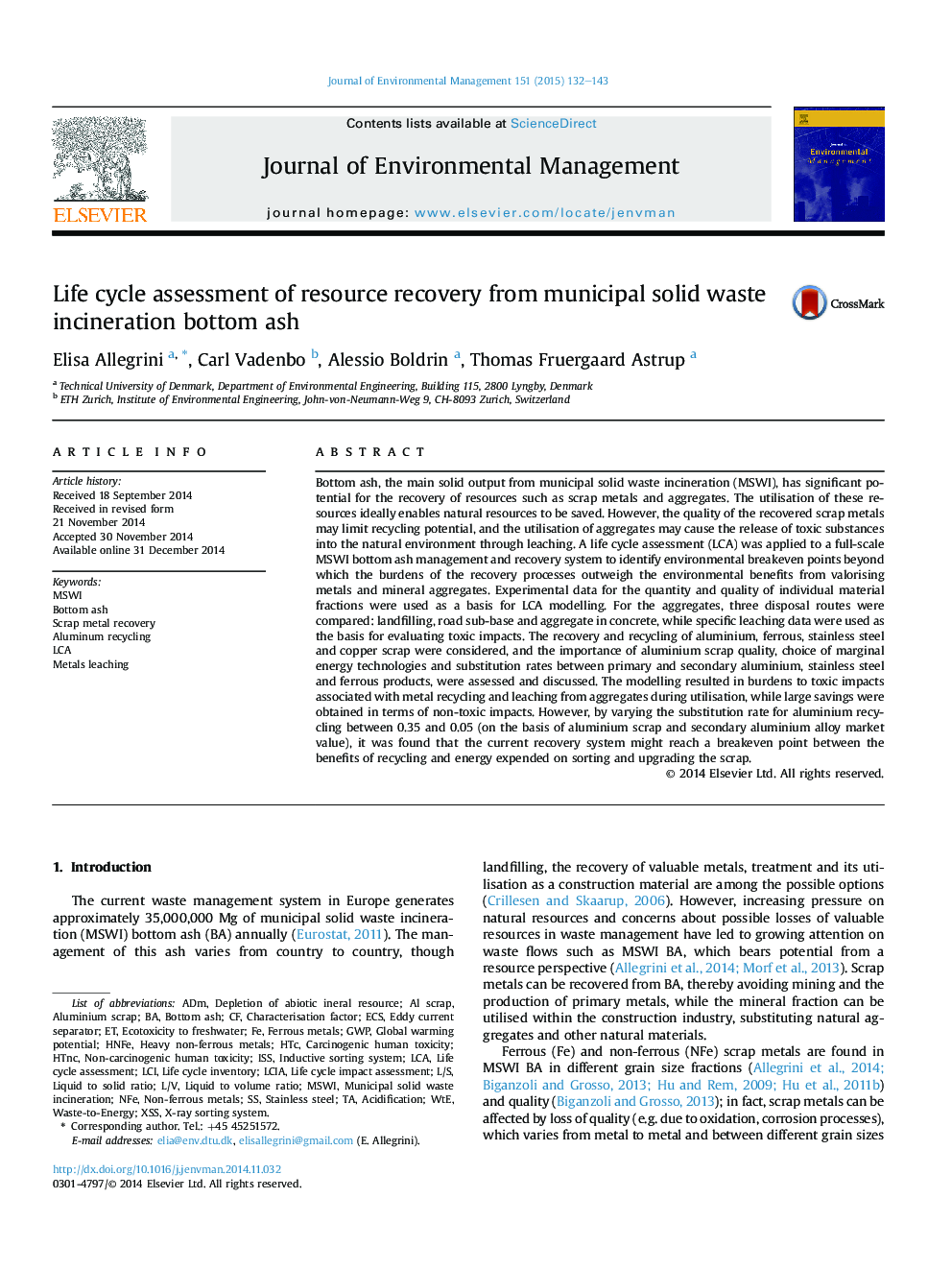| کد مقاله | کد نشریه | سال انتشار | مقاله انگلیسی | نسخه تمام متن |
|---|---|---|---|---|
| 7482727 | 1485261 | 2015 | 12 صفحه PDF | دانلود رایگان |
عنوان انگلیسی مقاله ISI
Life cycle assessment of resource recovery from municipal solid waste incineration bottom ash
ترجمه فارسی عنوان
ارزیابی چرخه زندگی از بازیابی منابع از خاک زغالسنگ جامد زباله های جامد
دانلود مقاله + سفارش ترجمه
دانلود مقاله ISI انگلیسی
رایگان برای ایرانیان
کلمات کلیدی
NFECharacterisation factorXSSGWPLCIAMSWIWTEADMHTCLCIISSWaste-to-energy - (تبدیل) زباله به انرژیECs - EC هاL/S - L / SLife cycle impact assessment - ارزیابی تاثیر چرخه زندگیLCA - ارزیابی چرخه حیاتLife Cycle Assessment - ارزیابی چرخه عمر یا چرخه حیاتAcidification - اسیدی شدنAluminum recycling - بازیافت آلومینیومBottom ash - خاکستر پایینMunicipal solid waste incineration - سوزاندن زباله های شهریFerrous metals - فلزات آهنیNon-ferrous metals - فلزات غیر آهنیStainless steel - فولاد ضد زنگLife Cycle Inventory - موجودی چرخه زندگیLiquid to solid ratio - نسبت مایع به جامدglobal warming potential - پتانسیل گرمایش جهانی
موضوعات مرتبط
مهندسی و علوم پایه
مهندسی انرژی
انرژی های تجدید پذیر، توسعه پایدار و محیط زیست
چکیده انگلیسی
Bottom ash, the main solid output from municipal solid waste incineration (MSWI), has significant potential for the recovery of resources such as scrap metals and aggregates. The utilisation of these resources ideally enables natural resources to be saved. However, the quality of the recovered scrap metals may limit recycling potential, and the utilisation of aggregates may cause the release of toxic substances into the natural environment through leaching. A life cycle assessment (LCA) was applied to a full-scale MSWI bottom ash management and recovery system to identify environmental breakeven points beyond which the burdens of the recovery processes outweigh the environmental benefits from valorising metals and mineral aggregates. Experimental data for the quantity and quality of individual material fractions were used as a basis for LCA modelling. For the aggregates, three disposal routes were compared: landfilling, road sub-base and aggregate in concrete, while specific leaching data were used as the basis for evaluating toxic impacts. The recovery and recycling of aluminium, ferrous, stainless steel and copper scrap were considered, and the importance of aluminium scrap quality, choice of marginal energy technologies and substitution rates between primary and secondary aluminium, stainless steel and ferrous products, were assessed and discussed. The modelling resulted in burdens to toxic impacts associated with metal recycling and leaching from aggregates during utilisation, while large savings were obtained in terms of non-toxic impacts. However, by varying the substitution rate for aluminium recycling between 0.35 and 0.05 (on the basis of aluminium scrap and secondary aluminium alloy market value), it was found that the current recovery system might reach a breakeven point between the benefits of recycling and energy expended on sorting and upgrading the scrap.
ناشر
Database: Elsevier - ScienceDirect (ساینس دایرکت)
Journal: Journal of Environmental Management - Volume 151, 15 March 2015, Pages 132-143
Journal: Journal of Environmental Management - Volume 151, 15 March 2015, Pages 132-143
نویسندگان
Elisa Allegrini, Carl Vadenbo, Alessio Boldrin, Thomas Fruergaard Astrup,
